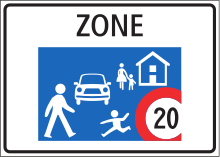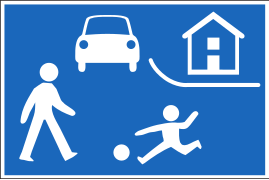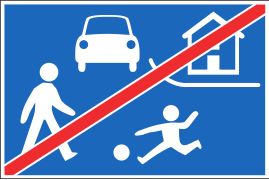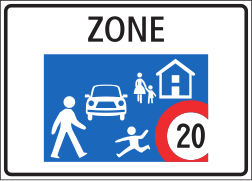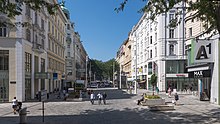Encounter zone


A meeting zone is a form of traffic calming in which pedestrians have right of way over vehicles. It was originally introduced in Switzerland , but has now also been introduced in other countries such as Belgium, Austria and France. It aims to increase the attractiveness of the street space and increase traffic safety by weighting residential and business use more heavily than traffic and improving the living and traffic conditions for slow traffic.
The areas of application are diverse and mainly include station forecourt, inner city and school areas, residential and central business districts as well as central squares or intersections with high pedestrian and bicycle traffic. The versatile area of application is an innovation in the field of traffic calming and differentiates the encounter zone from the traffic-calmed area in Germany, which has different traffic rules and is limited to residential areas and areas with little traffic.
distribution
- In Switzerland, the concept has been regulated in the Signaling Ordinance since January 1, 2002 .
- In Belgium (since 2004) and in France (since 2008) the traffic concept exists as a zone de rencontre . This is also how it is called in the French-speaking part of Switzerland .
- In Austria , the National Council passed an amendment to the road traffic regulations on January 31, 2013 , which enables the creation of meeting areas.
- In Germany so far there is only the traffic-calmed area and the traffic-calmed business area , both of which differ in essential points from the encounter zone: While in the encounter zone Tempo 20 and a priority for pedestrians apply, in the traffic-calmed area you can only drive at walking speed and Driver and pedestrian have equal rights. In the traffic-calmed business area , higher speeds apply (e.g. as a 20-speed zone), but pedestrians do not have priority and generally do not share the traffic area with vehicles. One example of such a project is Maaßenstrasse in Berlin-Schöneberg. The implementation of the project began in 2015. It is to be further developed in a second stage (“Encounter Zone 2.0”) with strong citizen participation.
National
Switzerland
In Switzerland, according to Art. 22b of the Swiss Signaling Ordinance (SSV):
- The signal “meeting zone” (2.59.5) marks streets in residential or business areas, on which pedestrians and users of vehicle-like devices are allowed to use the entire traffic area. You have the right to enter the vehicle driver , but you must not obstruct the vehicle unnecessarily.
- The maximum speed is 20 km / h.
- Parking is only permitted in the places indicated by signals or markings. The general parking regulations apply to the parking of bicycles .
The requirements for the redesign are relatively low. a. that gates or gate-like situations illustrate the transition to the encounter zone. In addition, pedestrian crossings must be strictly avoided in the meeting zone . Cantons and communes have the greatest possible freedom in ordering accompanying measures to calm traffic. After one year at the latest, the implemented measures must be checked by the cantons for their effectiveness. Measures that are too ineffective must be improved.
Development in Switzerland
In the 1980s, residential streets based on the Dutch model were set up in Switzerland (see Woonerf ). The requirements for the implementation of a residential street were much stricter than today for the meeting zone: The complex structural measures to improve the quality of life and stay were usually very cost-intensive and the process required to obtain approval was very lengthy. The traffic sign corresponded roughly to today's sign for the encounter zone, but without the maximum speed in the lower right corner. In 1995 an attempt was made to create a simplified residential street in Burgdorf called the promenade zone . With the success of the strolling zone , the name was changed to encounter zone in 2001 and the concept was officially introduced in 2002.
Austria
The pedestrian zone (§ 53 9a / b StVO) and the residential street (§ 53 9c / d StVO) have existed in Austria for a long time . With the amendment to the road traffic regulations , the meeting zone (§53 9e / f StVO) was introduced in 2013 .
In contrast to other EU countries, pedestrians in Austria are not allowed to enter, but are on a par with other means of transport.
In detail it says as follows:
“Pedestrians are allowed to use the entire lane. However, you may not deliberately obstruct vehicle traffic "
The following also applies to vehicles:
“Drivers are not allowed to endanger or hinder other road users such as pedestrians or cyclists. You have to maintain a lateral distance from stationary objects or facilities corresponding to traffic safety "
In general, Tempo 20 applies in meeting areas. However, Austrian law provides for exceptions, especially if it "serves to make traffic easier and more fluid and there are no objections to it for reasons of traffic safety". Taking this into account, encounter zones with a maximum speed of 30 km / h may be set up.
In Austria, a basic distinction is made between three different structural types of meeting zones (FSV 2014, 2f):
- Streets: Streets with high pedestrian traffic and additional need to cross are the most common type.
- Places: Central places or places in front of public-intensive facilities (train stations, etc.) are particularly interesting in terms of urban planning. An improved center effect can be achieved through meeting zones. A meeting zone is particularly recommended if it is not possible to separate the individual types of traffic.
- Roads with a narrow cross-section: This type is recommended by the FSV if the total width of the road cross-section does not allow all road users to have areas of the same width. This is mainly used to provide legal protection for pedestrians.
Development in Austria
Before the introduction of the meeting zone under road traffic law in 2013, around a dozen pilot projects were launched, including in Graz and Villach . The first encounter zone of all three types, mixed as a too narrow village square with a thoroughfare, was the L103 through Thalgau ( coexistence zone 2012, planned by the Bad Architects Group).
- See also: List of shared space projects: Austria
Following the amendment to the road traffic regulations, meeting zones were implemented in several other cities in Austria from 2013, including in Mariahilfer Strasse in Vienna. The Schleifmühlbrücke, which crosses Vienna's Naschmarkt , has been a level meeting area since October 2015 and is therefore also available as a connection for cars at 20 km / h.
The Walk-space.at association lists 71 projects in Austria on its website (as of August 2019).
See also
- Shared space
- Bernese model
- Pedestrian zone , residential street , play street , traffic-calmed area , traffic-calmed business area
- Woonerf
literature
- Florian Hofer: Meeting zones in Austria. Analysis of selected examples based on qualitative criteria. Master's thesis, University of Natural Resources and Life Sciences, Vienna, April 2016 ( pdf , boku.ac.at) - comparative study, particularly with Switzerland.
Web links
-
encounter zones.ch
- Brochure from the Swiss Federal Roads Office ( FEDRO) (PDF file; 2.10 MB)
- admin.ch: Regulation text as PDF file (16 kB)
- encounter zones.de
- encounter zones.or.at
- dorfanger-blankenburg.de : Comparison of encounter zone , shared space and traffic-calmed area
Individual evidence
- ↑ Foot traffic in Switzerland (ed.): Accidents in meeting areas: Analysis of accident data before - after in Burgdorf, Biel, Lyss and Einsiedeln . Zurich, April 2008.
- ↑ SR 741.21 (Signalization Ordinance) Art. 22b: "Meeting zone"
- ↑ 25th Amendment to the StVO
- ↑ Claudius Prößer: Berlin meeting zones: pads on the way . In: The daily newspaper: taz . October 19, 2018, ISSN 0931-9085 ( taz.de [accessed November 8, 2018]).
- ↑ History of Swiss meeting areas
- ↑ Encounter Zones - Traffic Calming Measures , wien.gv.at, accessed on January 31, 2019
- ↑ Meeting zones in Austria , encounter zones.or.at under "Legal Information", accessed on January 31, 2019.
- ↑ Lit. Hofer 2016, 2.2. Areas of application and requirements , p. 20 (quoted verbatim).
- ↑ Encounter zones are slowly gaining ground in Austria ( Memento from May 27, 2014 in the Internet Archive ), VCÖ press release from July 25, 2013
- ↑ Meeting zone opened at Naschmarkt , orf.at, October 5, 2015, accessed on October 5, 2015.
- ↑ Project overview. In: Encounter Zones in Austria. Walk-space.at, accessed on February 2, 2019 .
